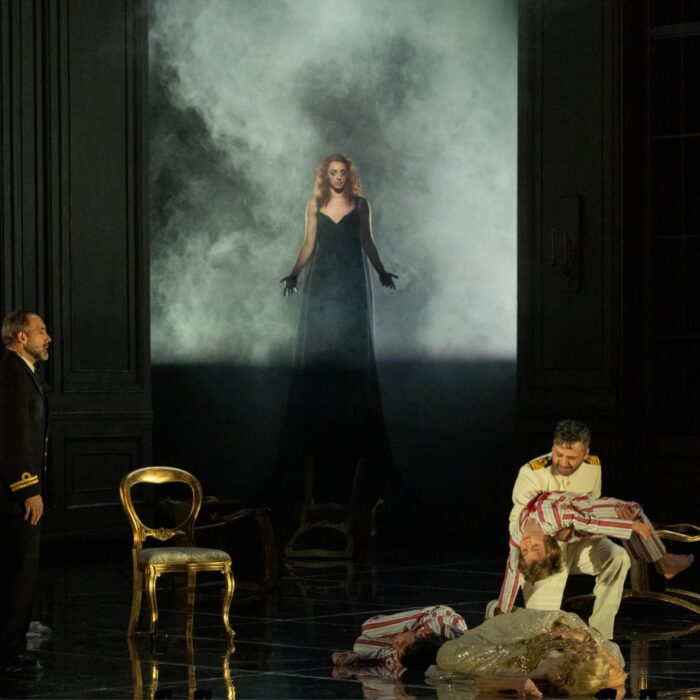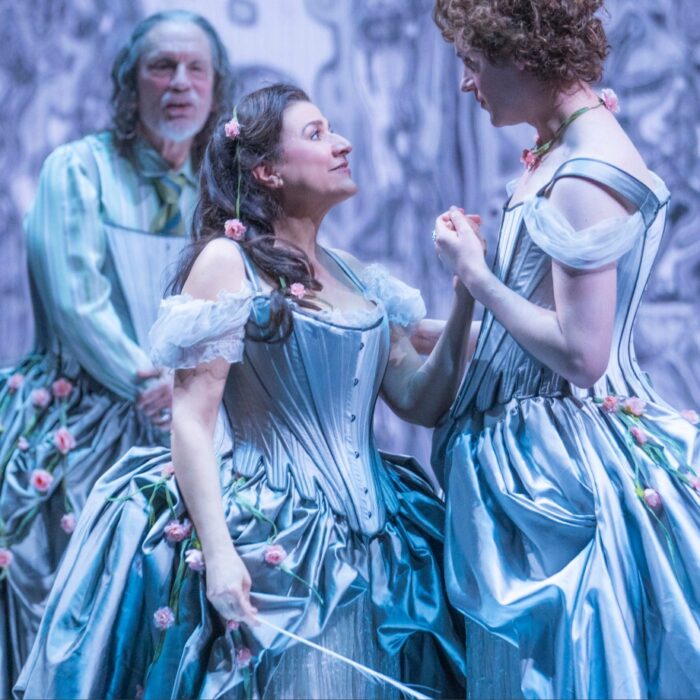
Staatsoper Berlin 2017-18 Review – King Arthur: A Highly Imaginative Take on the Purcell Work
By Lois SilversteinFor many, King Arthur is Britain.
Deep in the history and literature, he stands as an icon of Britain’s essence – heroic, brave, mighty, magnanimous – the pinnacle of the good, even if flawed as even the noblest are. Henry Purcell’s opera, a.k.a. semi-opera, “King Arthur,” set to English poet John Dryden’s libretto, incorporates some of these characteristics while it brings in many more. Berlin Staatsoper’s production by Sven-Eric Bechtolf and Julian Crouch, builds new creative visions onto these.
Even if you did not follow some of the swift narrative movement at a particular moment; even if you did not make the transition from English to German, or from speech to song; even if you did not register the exact moment when Then turned to Now and then to Tomorrow, before you was a superb piece of theater.
It originally opened in January 2017, and was performed in the Schiller Theater, while the Staatsoper on Unter den Linden was being restored – to high glamour and art. Then too, the SprecheTexte in both German by Wolfgang Wiens and Hans Drucker and Dryden’s English added the contemporary narrative that gave the old the new. Hardly any gaps between the worlds of historical and more modern entertainments, soloists and chorus, mood, comic, serious, fantastic, spoken and musical dialogue, let alone elaborate and multiple projections, videos by Joshua Higgason and light by Olaf Freese, aerial flights, with and without parachutes, 1940s radios and costumes, done by Kevin Pollard, over-sized puppets that gaggled across the stage in a touching and poignant way, well-integrated choreography by Gail Skrela, contributed to an artistic experience and an evening to remember. Magic, pure and simple.
Strong Musical Side
The music, conducted by Rene Jacobs, was excellent. From the Akademie Für Alte Musik Berlin, the orchestra maintained a lively and rhythmic pulse, the distinct sounds of Purcell’s instrumentation constant in the midst of the whirligig of activity of actors and singers unrolling the narrative on the stage above them. Continuo too emphasized the constancy of the musical line. The Staatsoper Choir, under the direction of Martin Wright, retained its elegant weight throughout.
This performance kept our attention in place and sustained concentration as well as enchantment through its numerous performers. Rather than familiar 19th century spotlight on tenor or baritone, soprano or mezzo, there were characters in a tale of Britain whose purpose was the transmission to eight-year-old Arthur, the legends of his father, the King, by his grandfather, on his birthday; this is the through-line on which varying sub tales are hung. Without superstars and operatic master-moments, we savored the Baroque as it delivered drama, story, and music for today.
Soprano Annette Frisch, playing the parts of Philadel and Cupid and Siren and Venus, sang with clear and refreshing line; Soprano Robin Johnson did just that as well. Benno Schacktner, Mark Milhofer, a and Stephan Rugamer exhibited finessed legato line, as did basses Neal Davies and Arthur Kataja. Many of these artists took on multiple roles, which was more than sleight of hand.
And Dramatics
The actors, including Arthur, played by Michael Rotschopf, Merlin, Jorg Gudzuhn, Oswald Max Urlacher and Osmund, Oliver Stokowski, were equally nimble in their delivery, at once playing for laughs, but never stopping there. Vaudevillian with a touch of Shakespearean comedy, while keeping our attention on the evolving messages they were transmitting. Grimbald, Tom Radisch, Conor, Axel Wandtke, Aurelius, Steffens Schortie Schumann, ballasted these as well as kept it all going. Emmeline, played by Meike Droste, and Mathilda, played by Sigurd Maria Schnuckel, provided lively contrast and necessary comedy. Young Arthur was performed by Ferdinand Kramer with deftness and ease. All maintained high levels of excellence.
High Spectacle
The production was indeed a high spectacle. It was an extravaganza of effects from opening striped wall-papered drawing room with family and friends celebrating young Arthur’s eighth birthday. Then it took flight to mysterious forests, Philadel parachuting down through projections of clouds; giant puppets bending and mimicking a contretemps with life-sized characters holding copies of the same characters in their arms, followed by a post-World-War Veterans Home where British flags flew and veterans donned party hats and undergarments. Needless to say, King Arthur’s descent in an airplane in which young Arthur eventually takes off “a la” Lindbergh, is not at all out of place. Time and place is elastic, and we zoom around happily with it, especially since it sustains the narrative purpose.
That said, the second half of the performance, according to some audience members’ reaction, did not manage as well, except perhaps for the outstanding Frost scene. For instance, the radio commercial for British Wool, supplemented by projections of sheep plus the cliche “no animal were hurt in the making of this ad” felt unnecessary. Ditto for the Circean love-making scene while integrated via projection and “live” frolicking in the blue-green waters, went on a tad too long, dictated perhaps for audience response solely; even the hauling off of father by son from the extremity of seduction and submission, forced our attention from “message” to sheer entertainment and drew attention from the larger scope the mythologizing and aggrandizing of public appreciation and extolling of the British world. But, it certainly never drew us away from the overall instruction and allegorical intentions to which such entertainment aimed.
In all, Dryden and Purcell, Bechtolf, Crouch, Jacobs, and their highly imaginative design team, lifted us into the realm of time and legend that skated skillfully on the timeless.


